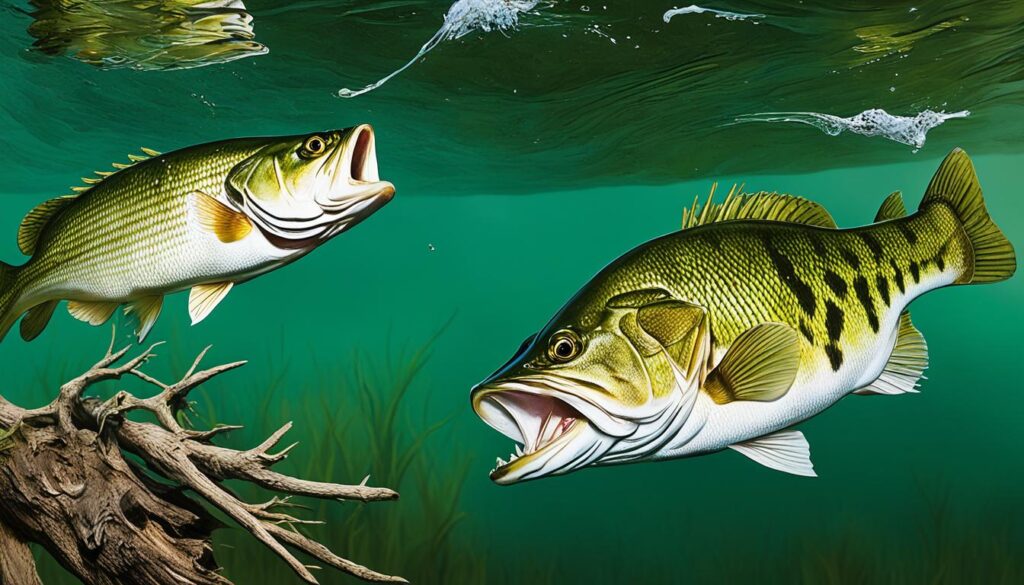If you’re into fishing or just curious about amazing creatures, prepare for some exciting largemouth bass fun facts! These freshwater giants are known for their impressive size, strength, and love of a good fight. They can grow up to 2 feet long and weigh over 20 pounds, making them a dream catch for avid anglers.
Found in lakes, rivers, and ponds across North America, largemouth bass love places with lots of plants and hiding spots. They’re skilled ambush predators, lurking in the shadows to surprise their prey.
So, whether you’re an experienced angler or just love learning about nature, these largemouth bass fun facts will surely make you appreciate these remarkable fish even more! Get ready to dive into the exciting world of largemouth bass!
Largemouth Bass Fun Facts: 15 Fascinating Tidbits
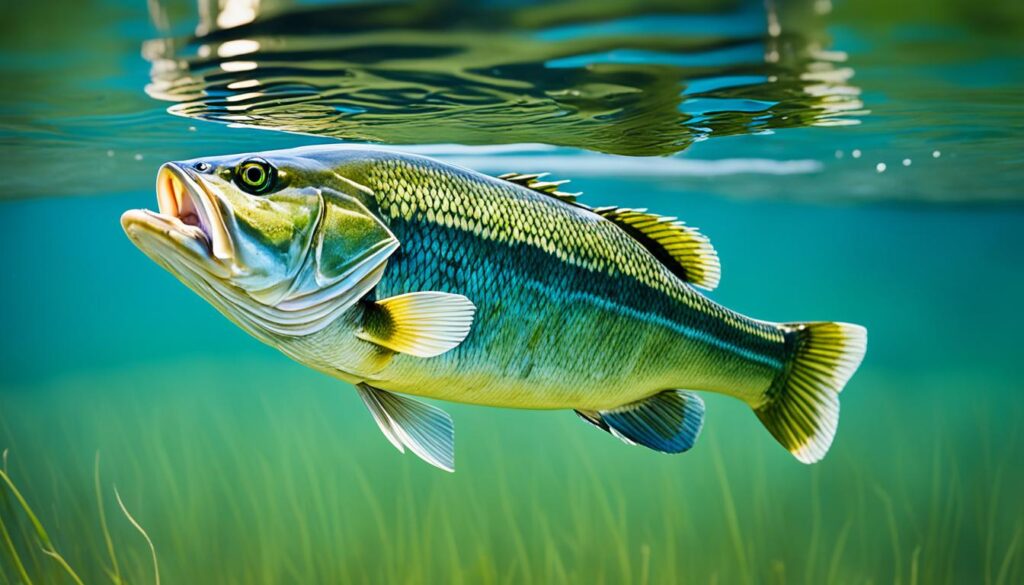
- Native Wonders: Largemouth bass are native to North America and can be found in almost every state.
- Hungry Hunters: With a big appetite, they eat everything from small fish to bugs, frogs, and even small mammals!
- Perfect Predators: Largemouth bass are masters of ambush, using their camouflaged bodies to sneak up on their prey.
- Big and Bold: These fish can grow as big as a 2-foot ruler and weigh more than 20 pounds!
- Fishing Favorites: Anglers love largemouth bass for their size and the challenge they pose during a catch.
- Habitat Havens: They thrive in waters with lots of plants and hiding spots, like lakes and rivers.
- Sneaky Strikers: Largemouth bass use their powerful tails to strike and capture their prey in a flash.
- Mouth of the Beast: Their giant mouths can swallow prey almost as big as their own bodies!
- Adaptable Adventurers: These fish can survive in different water conditions, from clear lakes to muddy ponds.
- Breeding Beauties: During spawning season, male largemouth bass guard their nests fiercely until the eggs hatch.
- Social Swimmers: They often hang out in groups, especially when hunting or seeking shelter.
- Night Owls: Largemouth bass are most active at dawn and dusk, using low light to their advantage.
- Silent Communication: They communicate with each other through body language and vibrations in the water.
- Top of the Food Chain: As apex predators, they play a crucial role in maintaining the balance of aquatic ecosystems.
- Conservation Concerns: Protecting largemouth bass habitats is essential for preserving their populations and the ecosystems they inhabit.
Unlocking the Mysteries of Largemouth Bass Spawning
Spring brings more than just warmer weather—it’s also when largemouth bass kicks off their fascinating spawning ritual. Let’s dive into their nesting habits and mating rituals!
Nesting Habits: When the water warms up, male largemouth bass become busy builders. They clear away debris to create shallow nests, which they guard with utmost care until the females arrive.
Mating Rituals: It’s all about the dance of courtship for these fish! Males flaunt their fin flares and tail slaps to woo the females to their meticulously crafted nests. Once a female chooses a nest, she deposits her eggs, and the male fertilizes them. This dance continues until all her eggs are laid.
Fishing the Spawn: Anglers, listen up! Understanding bass spawning behavior is like unlocking a treasure chest. By targeting these nesting areas and using lures that mimic baitfish or dare to invade the nests, anglers can trigger territorial strikes from protective males.
By mastering the art of understanding nesting habits, mating rituals, and territorial instincts during spawning season, anglers can maximize their chances of reeling in these captivating fish. So, prepare to time your tactics perfectly and catch largemouth bass at their most fascinating time of year!
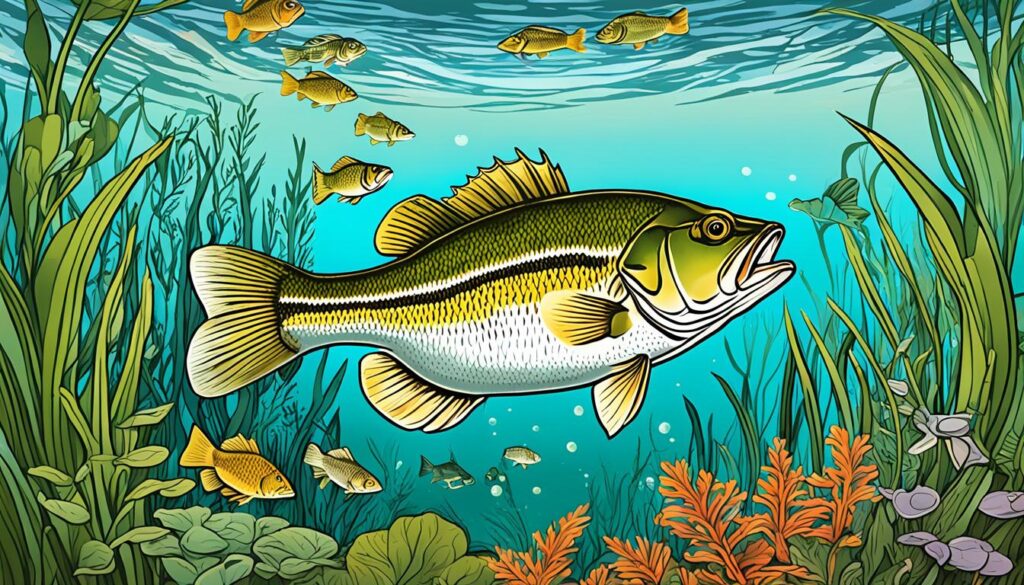
Unveiling the Appetite of Largemouth Bass
Largemouth bass are known for their remarkable predatory skills in feeding habits. Understanding their prey preferences and hunting strategies is crucial for anglers seeking to catch these elusive fish.
Largemouth bass are the masters of the underwater hunt, and getting to know their feeding habits is like cracking open a treasure chest for anglers. Let’s dive into their dining preferences and sneaky strategies!
Bass Diet: A Feast Fit for Predators
Largemouth bass aren’t picky eaters—they’ll devour almost anything that crosses their path! From underwater critters to land-dwelling creatures, they’ve got a varied menu. Their tastes change depending on the weather, time of day, and what’s on the menu nearby.
While they’re big fans of fish, tiny guys like shad, bluegill, and minnows, largemouth bass also munch on crustaceans, bugs, frogs, and even small birds or mammals that get too close to the water.
Ambush Predators: Masters of Stealth
Things get interesting here: bass must catch up on chasing their dinner. Instead, they’re all about the ambush. They’ll hide in the shadows, blending into their surroundings like stealthy ninjas, waiting for the perfect moment to strike.
When the time is right, they unleash a lightning-fast attack, snapping up their unsuspecting prey with a quick flick of their powerful jaws.
Size Matters: Choosing the Right Bite
Have you ever heard the phrase “bite off more than you can chew”? Well, largemouth bass knows all about that. They’re wise about their meals, aiming for prey that’s just the right size—about one-third of their length.
When young, they go for smaller snacks like bugs and tiny fish. But as they grow bigger and stronger, they set their sights on larger prey, like their fellow fishy friends.
So, whether you’re an angler looking for the perfect bait or just curious about the secrets of the deep, understanding the feeding habits of largemouth bass will give you a whole new appreciation for these underwater predators!
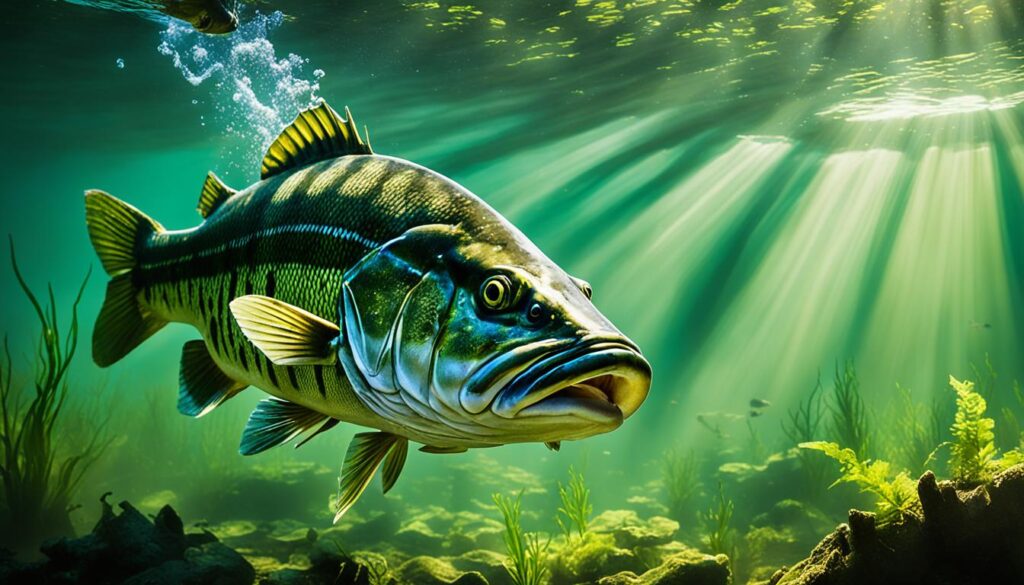
Caring for Bass: A Guide to Responsible Conservation
Looking out for our bass buddies is super important! Let’s talk about how we can keep their populations thriving and their habitats healthy through some responsible conservation efforts.
Catch-and-Release: Let Them Swim Another Day
One excellent way to help out bass is through catch-and-release programs. Instead of keeping every fish you catch, these programs encourage you to let them go. This gives the bass a chance to grow and make more baby bass, so there’s plenty to catch in the future.
Educating Anglers: Knowing is Caring
It’s all about spreading the word! By teaching anglers about conservation’s importance, we can ensure everyone’s on the same page. Understanding how bass fit into their ecosystem and why keeping their populations healthy helps us make wise choices when on the water.
So, whether you’re a seasoned angler or just getting started, remember: every little bit helps when it comes to looking after our bass buddies! Let’s keep those catch-and-release programs going strong and keep spreading the word about responsible fishing practices.
Organizations Dedicated to Bass Conservation
| Organization | Mission |
|---|---|
| B.A.S.S. | Protecting and enhancing the sport of bass fishing |
| Ducks Unlimited | Conserving, restoring, and managing wetlands and associated habitats |
| Coastal Conservation Association | Advocating for the health and sustainability of coastal ecosystems |
| Florida Fish & Wildlife Conservation | Protecting Florida wildlife & natural resources |
Our Duty as Anglers: Preserving Our Precious Fish
Hey, fellow anglers! It’s up to us to be the guardians of the fish we adore. Let’s chat about why conservation is critical and how we can make a big difference for our beloved bass buddies!
Why Anglers Matter in Bass Conservation
We’re not just here to catch fish—we’re here to protect them, too! Anglers like us play a super important role in ensuring that bass populations stay healthy and strong for years to come. How? By practicing catch-and-release and following fishing rules that keep things sustainable, we’re helping bass thrive.
But that’s not all! We can also get our hands dirty (well, maybe a little muddy) with habitat restoration projects. By pitching in to clean up waterways and protect the areas where bass live, we’re creating awesome homes for them to grow and flourish.
So, let’s keep up the good work, anglers! Every catch we release and every bit of habitat we protect makes a big difference in keeping our bass buddies happy and healthy. Together, we’ve got this! 🎣🌊
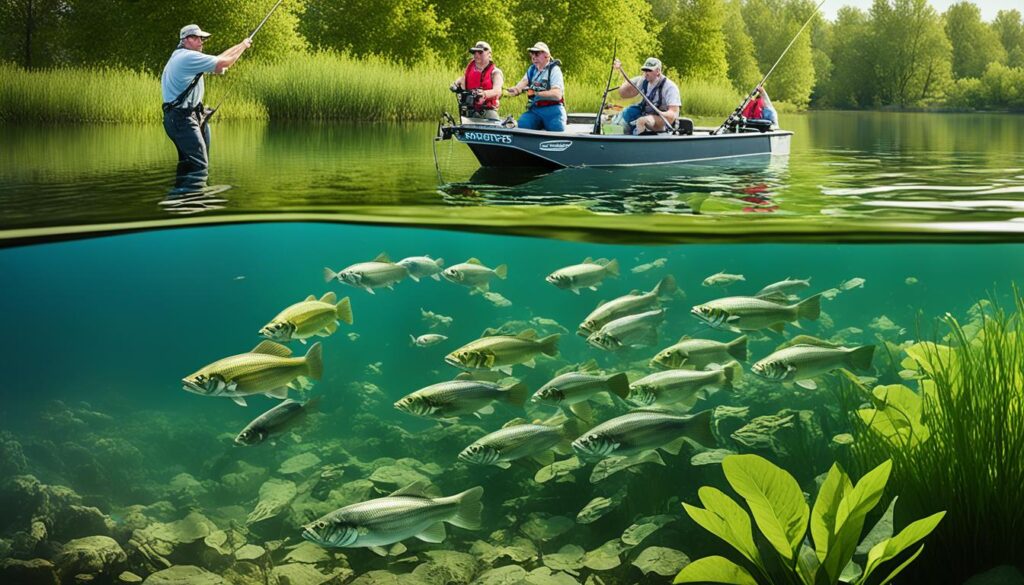
Discover the Amazing World of Largemouth Bass: 15 Jaw-Dropping Facts!
Get ready to dive into the fascinating largemouth bass world with these incredible facts that’ll blow your mind!
- Growth Spurts: Largemouth bass are like speed demons of the fish world! In just one year, they can pack on 1 to 2 pounds, with some superstars tipping the scales at over 20 pounds!
- Master of Disguise: These bass are the ultimate hide-and-seek champions! With their greenish-brown color and sneaky dark patterns, they blend seamlessly into their surroundings, turning into stealthy predators.
- Stealth Strikes: Forget chasing—bass is all about the ambush! They lurk near logs, rocks, or plants, waiting patiently to surprise their prey. Talk about strategy!
- Jaw-Dropping Power: Watch out for those jaws! With mouths that can stretch and rows of razor-sharp teeth, bass can gulp down prey up to a quarter of their size. Now that’s a big bite!
- Night Owls: These bass love burning the midnight oil! While they’ll nibble during the day, they’re most active when the lights are low, making dawn, dusk, and night the perfect times for a fishing adventure.
- Family Matters: When it comes to parenting, bass take it seriously! After the lady bass lays her eggs, it’s up to the guy to stand guard and protect the nest until the little ones hatch. Talk about dedication!
- Where’s Waldo?: You can find bass all over the place! From lakes and rivers to ponds and reservoirs, they’re the ultimate adventurers, exploring every freshwater nook and cranny.
- Top of the Class: In bass society, size matters! The bigger fish call the shots, showing their dominance with flashy moves and territorial squabbles. It’s like high school drama, but underwater!
- Breathing Easy: Bass have a nifty trick for surviving in tough spots. They can gulp air from the surface, giving them an edge in low-oxygen waters where other fish struggle to breathe.
- Golden Years: With the right conditions, bass can stick around for quite a while! Some lucky ones can live up to 16 years or more, depending on food, water, and fishing pressure.
- Colorful Characters: Bass aren’t afraid to show off their style! Depending on where they hang out and what’s in the water, their colors can change like a mood ring, from deep greens to bold patterns.
- Green Hideaways: If you’re looking for bass, check out the greenery! They love hiding in plants like lily pads and grass beds, using them as launchpads for surprise attacks.
- Temperature Talks: Bass are pretty picky about their water temperature. They like it just right—between 75°F and 86°F—to keep their energy and appetites roaring.
- Striking Gold: Hold on tight when a bass goes for your bait! Their strikes are legendary, packing a punch that’ll get your heart racing faster than a roller coaster.
- Trophy Time: Bass aren’t just a catch—they’re a celebration! Anglers everywhere are on the hunt for those big, beautiful bass, not just for the thrill, but to honor the strength and beauty of these fantastic fish.
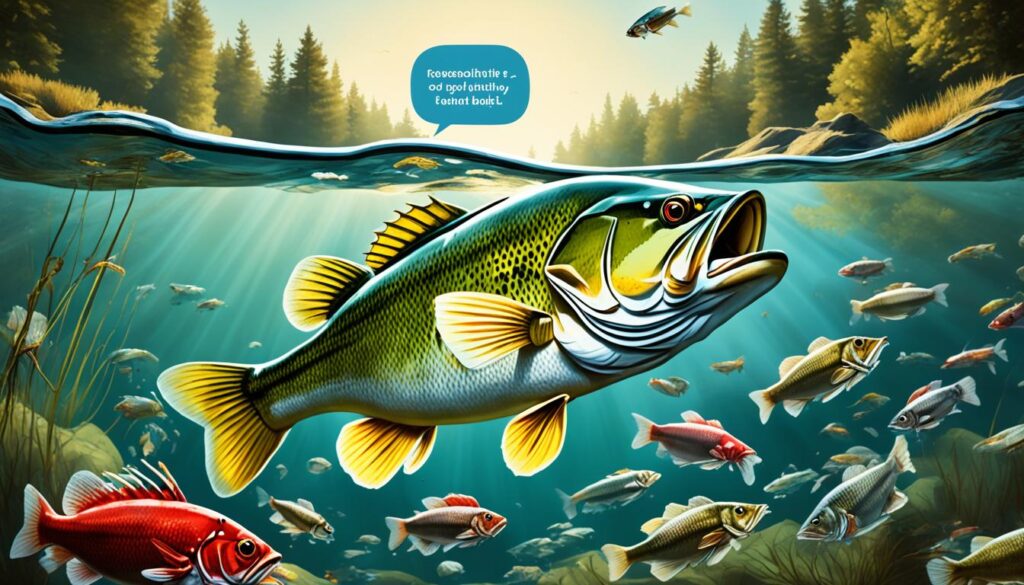
Dive into the Exciting World of Bass Fishing
Get ready for an adrenaline rush as we explore the thrilling realm of bass fishing! As an angler, few experiences compare to the heart-pounding pursuit of the mighty largemouth bass. With its powerful strikes, acrobatic jumps, and fierce fights, it’s no wonder this fish is a top favorite among anglers everywhere.
The Art of Bass Fishing
To reel in that trophy bass, you’ll need more than just luck—you’ll need skill and knowledge, too! Understanding the behavior and habits of largemouth bass is vital to success on the water. Let’s dive into some tried-and-true techniques, equipment, and strategies that passionate anglers swear by:
- Gear Up Right: Equip yourself with the perfect gear for the job. Opt for a medium- to medium-heavy fishing rod, around 6 to 7 feet long, paired with a sturdy baitcasting or spinning reel. For that added advantage, spool up a reliable monofilament or fluorocarbon line in the 10 to 15-pound test range.
- Master Your Techniques: There’s more than one way to lure in those bass beauties! From topwater fishing to spinnerbait tactics, jigging, and flipping and pitching, each technique has its own charm. Experiment with different methods to see what works best for you and your fishing conditions.
- Decode Bass Behavior: Know thy prey! Largemouth bass love to hang out near structures like fallen trees, submerged vegetation, and rocky hideouts. Understanding their habitat preferences can help you pinpoint their hiding spots and reel in the big ones.
- Stay Sharp: Bass fishing always evolves, so keep up with the latest trends and techniques. Dive into fishing magazines, watch informative videos, and connect with fellow anglers online to stay in the loop. Learning from others and adapting to changing conditions will strengthen your fishing game.
Now that you’re armed with the knowledge and know-how, it’s time to cast your line and embark on your bass fishing adventure! Remember, every strike, jump, and catch is a chance to create unforgettable memories. So, grab your gear, hit the water, and let the thrill of bass fishing take you on an unforgettable journey! 🎣🌊
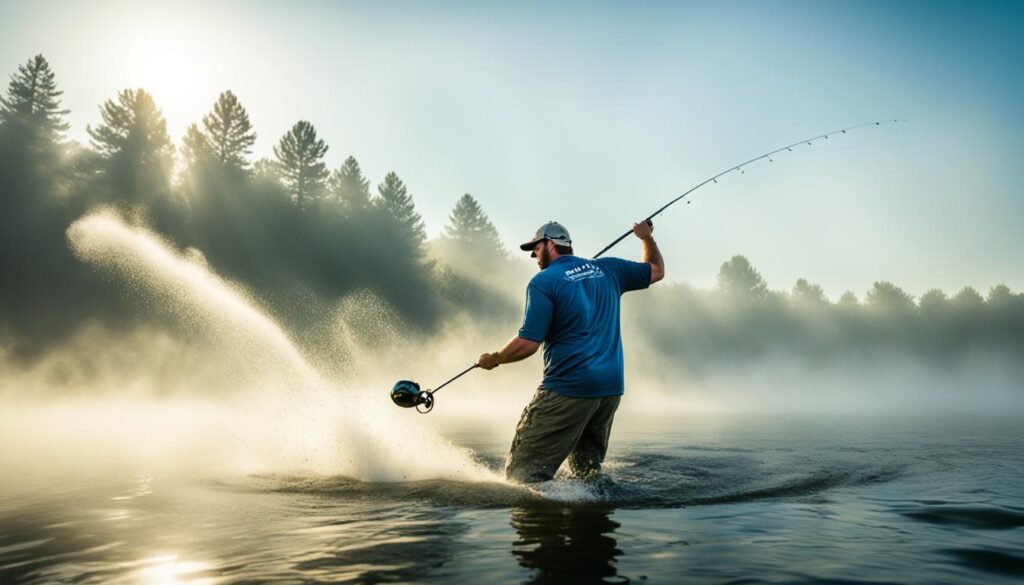
Exploring the Fascinating World of Largemouth Bass
What an adventure it’s been diving into these 15 captivating largemouth bass fun facts! I hope you’ve enjoyed uncovering the secrets of the bass fishing world as much as I have. From their mesmerizing spawning behavior to their incredible feeding habits, it’s clear that largemouth bass is genuinely one-of-a-kind.
But our journey doesn’t end here. It’s up to us to be stewards of the waters we love. Responsible conservation efforts are crucial for preserving the magic of this iconic species. By embracing sustainable fishing practices and involving conservation initiatives, anglers can make a real difference in safeguarding the future of largemouth bass populations.
As you continue your bass fishing journey, remember to savor every moment of the chase. The thrill of hooking into one of these elusive fish is what makes bass fishing so exhilarating. So, keep exploring, learning, and marveling at this extraordinary species’ wonders. Here’s to many more unforgettable adventures on the water! 🎣🌊
FAQ
What are some interesting facts about largemouth bass?
Largemouth bass are known as “big mouth bass” due to their large mouths and impressive predatory abilities. They can grow up to 2 feet in length and weigh over 20 pounds. Bass have excellent eyesight and can spot prey in murky water. They are also known for their aggressive strike when hunting.
Where can largemouth bass be found?
Largemouth bass are native to North America and can be found in freshwater lakes, ponds, rivers, and reservoirs throughout the United States. They prefer habitats with submerged vegetation, such as lily pads and fallen trees, where they can hide and ambush their prey.
What is the spawning behavior of bass?
Bass spawn during the spring months when water temperatures reach around 60 to 70 degrees Fahrenheit. The male bass creates a nest in shallow water by clearing away debris and creating a circular depression. The female lays her eggs in the nest, and the male guards and protects them until they hatch.
How do bass feed?
Largemouth bass are opportunistic predators and feed on a variety of prey, including fish, crustaceans, and insects. They use a sit-and-wait hunting strategy, patiently waiting for an unsuspecting prey to swim by before swiftly striking and engulfing it. Bass are also known to exhibit cannibalistic behavior, especially when larger bass prey on smaller individuals.
What conservation efforts are in place for bass?
Bass conservation efforts aim to protect and sustain bass populations. These efforts include catch-and-release practices, fishing regulations, and habitat restoration projects to enhance the quality of bass habitats. Anglers can contribute to conservation by practicing responsible fishing and respecting size and bag limits.
What are some fascinating facts about bass fish?
Bass have a unique ability to change their coloration and blend in with their surroundings, allowing them to become nearly invisible to their prey. They can also survive in a variety of water conditions, including low oxygen levels. Bass have an excellent sense of hearing and can detect vibrations in the water to locate prey.
How can I improve my bass fishing skills?
To enhance your bass fishing skills, it is important to study the behavior and habitat preferences of largemouth bass. Learn different fishing techniques, such as flipping, pitching, and topwater fishing. Experiment with various bait and lure choices to find what works best in different conditions. Practice casting accuracy and patience, as bass can be elusive at times.
